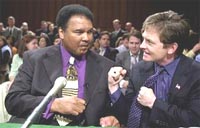"When Michael J Fox meet Muhammad Ali"
 What will happen when actor Michael J. Fox meet the former heavyweight boxing champion Muhammad Ali?
What will happen when actor Michael J. Fox meet the former heavyweight boxing champion Muhammad Ali? - Talk to the patient and proceed - monotonous speech
- This patient has unsteady gait. Please examine.- festinant, shuffling gait
By one look, you will notice the patient has expressionless, unblinking face. Then, look for hand tremor. Take a pillow and REST the elbow on the pillow to demonstrate resting tremor. Proceed by checking the presence of rigidity and bradykinesia. Once you demonstrated the 3 signs of Parkisonism, don't stop at this stage. As a physician, you need to assess the possibility of Parkinson's plus syndromes.
- Olivopontocerebellar degeneneration: check for cerebellar signs
- Steele-Richardson-Olszewski disease: check for gaze palsy and pyramidal signs
- Progressive autonomic failure(Shy-Drager syndrome): check for postural hypotension
Labels: Neurology








0 Comments:
Post a Comment
<< Home